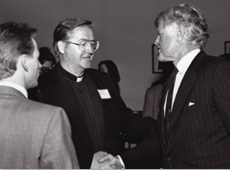ULSTER TV.Tuesday, 26 August 2014
“Things always look inevitable when you get them behind you, but there’s nothing inevitable about them at the time.”

The words of former Fianna Fáil politician Martin Mansergh who was Special Adviser to Taoiseach Charles Haughey and Albert Reynolds in the years leading up to the IRA ceasefire.
Looking back at Northern Ireland’s peace process, it is certainly striking how events and conditions conspired to bring about the fragile accord which resulted in the IRA announcing “a complete cessation of military operations” on the 31st August 1994.
Over the preceding 25 years 3,500 people were killed and 50,000 more were injured in the conflict referred to as the Troubles.
For a quarter of a decade republican and loyalist terrorists, as well as the security forces, were locked in a vicious cycle of violence which had left all sides exhausted and war-weary.
Eventually the combatants began to realise they were in a conflict they could not win or lose.
Sinn Féin’s Martin McGuinness said it was the realisation that they were in a stalemate that led republicans to consider an alternative to violence.
There’s no doubt the sickening atrocities were leaving the organisation extremely isolated politically. In 1987 the killing of 11 people in an IRA bomb attack on a Remembrance service in Enniskillen was a political and military disaster. It brought severe criticism from the United States and Europe. Even the Libyan regime – which had previously sent the IRA weapons – was critical.
But months later the SDLP leader John Hume began secret talks with the Sinn Féin President Gerry Adams.
Hume believed republicans might be persuaded to abandon violence and embrace a political stategy.
It was one of a number of conversations republicans were having in the late eighties and early nineties. The arrival of a new British Secretary of State Peter Brooke in 1989 brought a refreshing and pragmatic approach to the Northern Ireland. He publicly stated the British had “no selfish strategic interest” and then gave the go-ahead for secret talks.
By now the Irish had also begun to realise an opportunity existed. Martin Mansergh was despatched to have almost weekly meetings with Martin McGuinness in Dundalk.
And all of this was taking place against momentous global changes. In Germany the Berlin Wall had come down. The Israelis and Palestinians were talking in Oslo and in south Africa Nelson Mandela had walked free, paving the way for remarkable changes.
“It seemed possible to me that Sinn Féin and the IRA might have been concerned – Sinn Féin particularly – that they were going to be the last unsolved problem,” Lord Brooke told me.
In the end the Humes Adams initiative bore fruit.
In 1991 the SDLP leader passed a document detailing their discussions to the Irish government and from it the Downing Street Declaration was eventually agreed in 1993.
The document, signed by John Major and Albert Reynolds, accepted the people of Northern Ireland would be allowed to determine their own future, but, importantly, affirmed its constitutional status could only be changed when the majority consented.
Crucially it also came with a promise for republicans that they could be part of any political negotiations as long as they renounced violence.
It took months for the IRA to finally make its move but eventually on 31st August 1994 the long-awaited and anticipated ceasefire was announced.
I asked Martin McGuinness was he nervous that day. He told me he’s rarely nervous, but he did admit to some ‘concern’.
“We had our own credibility to think of in terms of our own supporters in Sinn Féin,” he said, “and within the IRA. The concern was that we had embarked on a proposition that would have effectively blown up in our face.”
Global headlines beamed around the world showed jubilant republicans celebrating in west Belfast, but not everyone was happy. Anthony McIntyre was a republican activist and a former IRA prisoner. He told me he viewed the republican cavalcade as “turkeys celebrating Christmas”. For him the opportunity of a place around the negotiating table fell far short of his aspirations for a united Ireland.
“I felt in many ways that what we were signing up to,” he said, “what we were being asked to sign up to and endorse and embrace was not a worthwhile return for the energy and effort and commitment put in by IRA volunteers. Nor did it in any was justify the loss of life.”
He wasn’t alone.
Within hours the Ulster Unionist leader James Molyneaux went to Downing Street to be briefed. For him and the rest of unionist commmunity a vital word was missing in the IRA statement. Permanent.
The rest, as they say, is history.
Over the next 18 months the opportunity presented by the cessation was lost amid calls for the IRA to confirm the ceasefire was permanent. Then came demands for decommissioning before negotiations could begin.
In February 1996 -18 months after announcing its ceasefire – the IRA bombed Canary Wharf.
The hard-won peace was over.
In a peace process that is littered with so many historic moments it is easy to forget some or underestimate their importance.
Unsurprisingly all the people I spoke to had various opinions on how history will judge the IRA ceasefire. For one it was a stepping stone, for another a defeat or at least a capitulation. Martin McGuinness told me it was the most important decision not just in the last 20 years but in the last 100 years.
What is undeniable though is the ceasefire announced in 1994 gave the people of Northern Ireland a glimpse of normality that they had been denied for 25 years. It also gave those working to build a lasting political settlement something to aim for.
There can be no doubt the 1994 ceasefire, imperfect and transitory as it may have been, was a game-changer.








